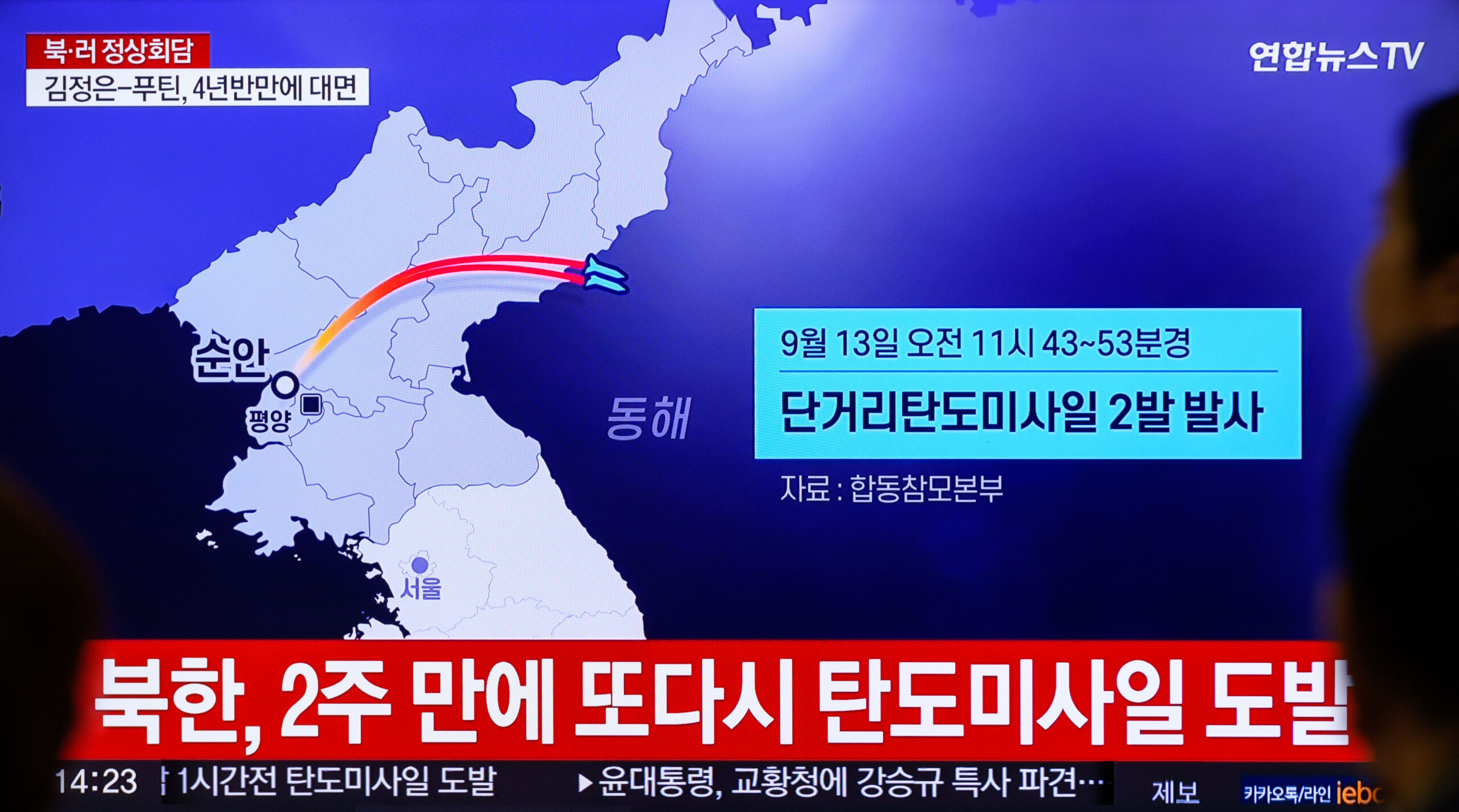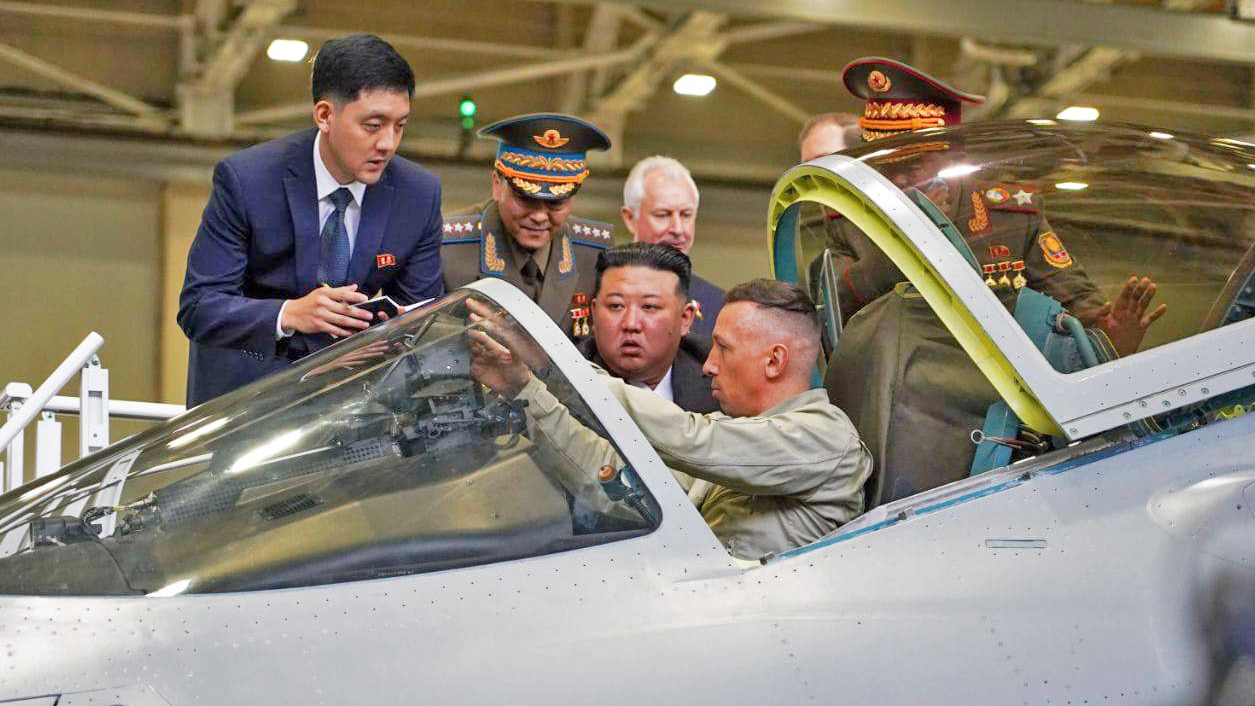North Korean leader Kim Jong Un visited a factory that builds advanced fighters today as his tour of Russia continues. Kim inspected manufacturing facilities at the Komsomolsk-on-Amur Aircraft Production Association, or KnAAPO, based in Komsomolsk-on-Amur in the Russian Far East, leading to no shortage of speculation that North Korea might be preparing to trade artillery shells and other materiel for new — or at least newer — jets to overhaul its badly aging air force.

Official photos released of Kim’s visit to KnAAPO showed the North Korean leader accompanied by Russia’s Deputy Prime Minister and Minister of Industry and Trade, Denis Manturov. Kim was seen looking into the cockpit of a Su-57 Felon next-generation fighter, as well as in the final assembly hall for the Su-35 Flanker multirole fighter, and watching a demonstration flight over the factory airfield by a pre-delivery Su-35.

Kim’s visit to KnAAPO came on the third day of his trip, which marks a very rare visit to a foreign country by the North Korean leader. Kim arrived in Komsomolsk-on-Amur in his favored style — aboard his specially equipped armored train, which had previously brought him across the border and then to the port city of Vladivostok.
Kim’s trip has also included meeting Russian President Vladimir Putin at the Vostochny Cosmodrome, a space facility in the far eastern Amur region. Discussions here reportedly included satellite technology, which North Korea is keen to obtain, as well as a potential deal to provide North Korean arms to Russia. An inspection of Russian Navy Pacific Fleet assets in Vladivostok is also planned.

While the specifics of any such deal to provide Russia with North Korean armaments have not been disclosed, Kim’s visit has repeatedly been framed by both countries in the context of Pyongyang’s staunch support for Russia against its Western foes and Russia’s need for North Korean ammunition. There has also been an exchange of rifles between Kim and Putin, the symbolism of which can hardly be overlooked.
Mikhail Degtyarev, regional of Khabarovsk Krai, where the KnAAPO facility is located, took to the Telegram messaging app to confirm Kim’s visit to the factory and also provided the following statement:
“Our fathers and grandfathers fought together against Japanese militarism, our country supported North Korea in its fight against the United States’ imperialist ambitions in the 1950s, and today we jointly stand up to the pressure of the collective West.”
Clearly, the Su-35 and Su-57 jets produced by KnAAPO would represent a huge upgrade over the severely outdated equipment that North Korea’s air arm currently flies. It’s possible that Moscow is offering these aircraft, or other advanced technologies to North Korea in order to secure the kinds of weapons it requires in high volumes — notably large volumes of artillery ammunition, rocket artillery, and anti-tank missiles, for example.

It should also be noted that the Su-57 has so far not secured any export orders and has only been rewarded with strictly limited orders, so far, from the Russian Ministry of Defense. India, formerly a partner in the program, dramatically pulled out, while an apparent pitch to Turkey failed to attract any serious interest beyond photo opportunities.

Planned deals to sell Su-35s to Egypt and Indonesia both collapsed, apparently under U.S. pressure and a proposal to transfer to Iran some of the jets already built for Egypt has so far not materialized.
Clearly, the current political climate, production limitations, and strict sanctions are already making the export of Russian defense equipment very complicated. A customer without such scruples, such as North Korea, could be an attractive alternative if the deal is right. If the Iranian deal does fall through, Pyongyang could also emerge as a potential candidate to buy the surplus Su-35s, too.
As well as fighters, North Korea would also almost certainly be interested in other Russian products, too, whether related to the modernization of other parts of its armed forces or to assist in furthering its own missile and space programs.
There remains the question, however, of what kinds of technologies Russia will actually be willing to share with North Korea. After all, in exchange, Russia would likely be seeking comparably unsophisticated munitions. Here, North Korea would be easily able to shore up gaps in Russian production capacity, with the potential to draw upon thousands of artillery pieces and literally millions of rounds of artillery ammunition and deliver them rapidly to meet the demand for the war in Ukraine.
Even if top-of-the-line Su-35s and Su-57s are not on the table, other less capable aircraft would still be a massive upgrade for Pyongyang compared to its existing fleet of older Russian-made jets, including old MiG-29 Fulcrum fighters and Su-25 Frogfoot ground-attack aircraft. Almost anything available from Russia would be sought after, whether MiG-29SMTs, Su-27s, or Su-30s. Even a supply of spare parts and overhauls of its current types would be of great value to Pyongyang.

On the other hand, Western officials, and the U.S. government in particular, are increasingly concerned that the deepening relationship between Moscow and Pyongyang is paving the way for more direct North Korean assistance for Russia in its war in Ukraine. Washington has already warned that North Korea would “pay a price” if it helped arm Russia at this point.
In a statement yesterday, U.S. National Security Adviser Jake Sullivan said he had discussed the possible repercussions of the Putin-Kim summit with his counterparts in South Korea and Japan. “They noted that any arms exports from the DPRK [Democratic People’s Republic of Korea] to Russia would directly violate multiple U.N. security council resolutions, including resolutions that Russia itself voted to adopt.”
North Korea has repeatedly denied providing Russia with weapons for the war in Ukraine, despite claims from the United States that it has done so, including arming the notorious Wagner Group private military company. More surprisingly, North Korean-made artillery rockets have also ended up in Ukrainian hands, although it’s unclear if these were captured from Russian positions or allegedly seized at sea by a friendly country and donated to Ukraine.
A South Korean Foreign Ministry spokesperson, Lim Soo-suk, said yesterday: “I think Russia has already tested the North Korean shells in battlefields and is now ready to expand its use going forward.”
For South Korea, the prospect of North Korea receiving high-end defense technology from Russia, in turn, is especially alarming.

Lim warned Russia of “very negative impacts” on its relations with Seoul if it continues to expand its military cooperation with North Korea.
Lim said: “We express our deep concern and regret that despite repeated warnings from the international community, North Korea and Russia discussed military cooperation issues, including satellite development, during their summit.” Ironically, Russia and South Korea previously had a military relationship of their own, primarily based around Moscow delivering various kinds of arms —including armored vehicles and anti-tank missiles — to Seoul as a way of paying back debts incurred during the Soviet era.

Specifically, Lim highlighted concerns about Pyongyang benefiting from “Any science and technology cooperation that contributes to nuclear weapons and missile development, including satellite systems that involve ballistic missile technologies.” Here it is worth recalling Kim’s visit to the Vostochny Cosmodrome this week, where talks are known to have touched upon possible Russian assistance for North Korea’s space program, which could well also encompass technology transfer related to ballistic missiles.
Kim’s current trip to the Russian Far East — which the Kremlin says will last “a few more days” — is also just the start of what looks set to be a series of reciprocal visits. Yesterday, the Kremlin confirmed that Putin had “gratefully accepted Kim’s invitation” to visit Pyongyang, although a timeline was not disclosed. Ahead of that, Moscow said it will “quickly prepare” to send Foreign Minister Sergei Lavrov to Pyongyang, with a trip expected in October.
Behind the symbolic value of Kim’s current visit, however, it remains unknown whether North Korea is poised to acquire at least newer fighters from Russia, however badly it might need them.
What is clear is that the Kremlin is now doing its utmost to forge a deeper relationship with North Korea, including across the military domain, and that this is very likely driven by an urgent need for artillery ammunition to help sustain its war in Ukraine. With that in mind, Moscow may well be willing to offer its own high-tech arms as well as technology transfers if it means it can obtain the weapons it needs.
Contact the author: thomas@thewarzone.com
